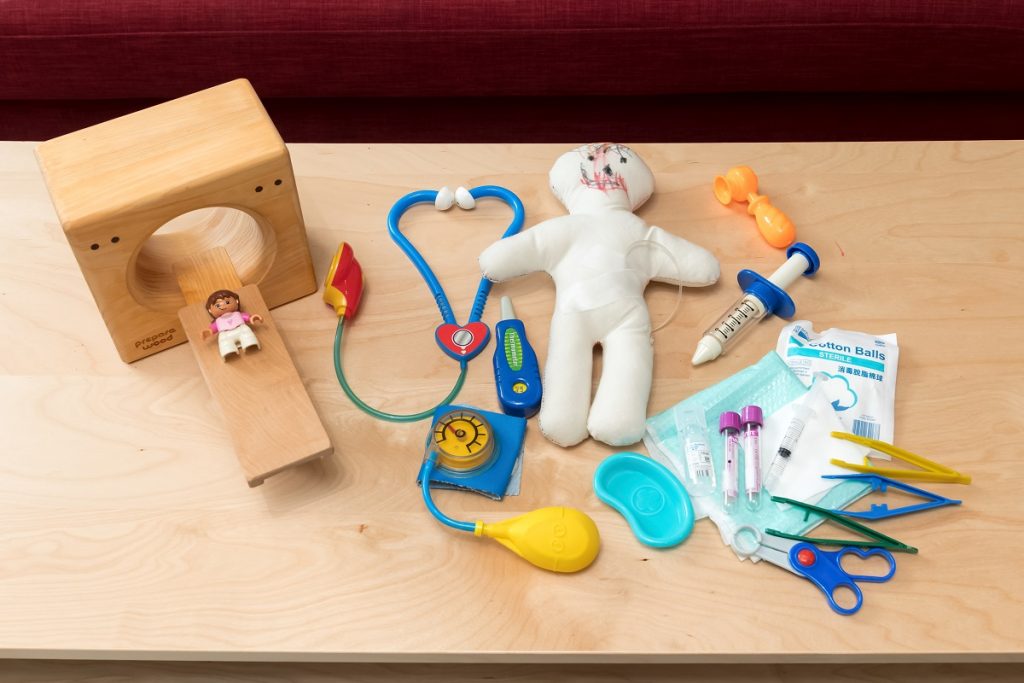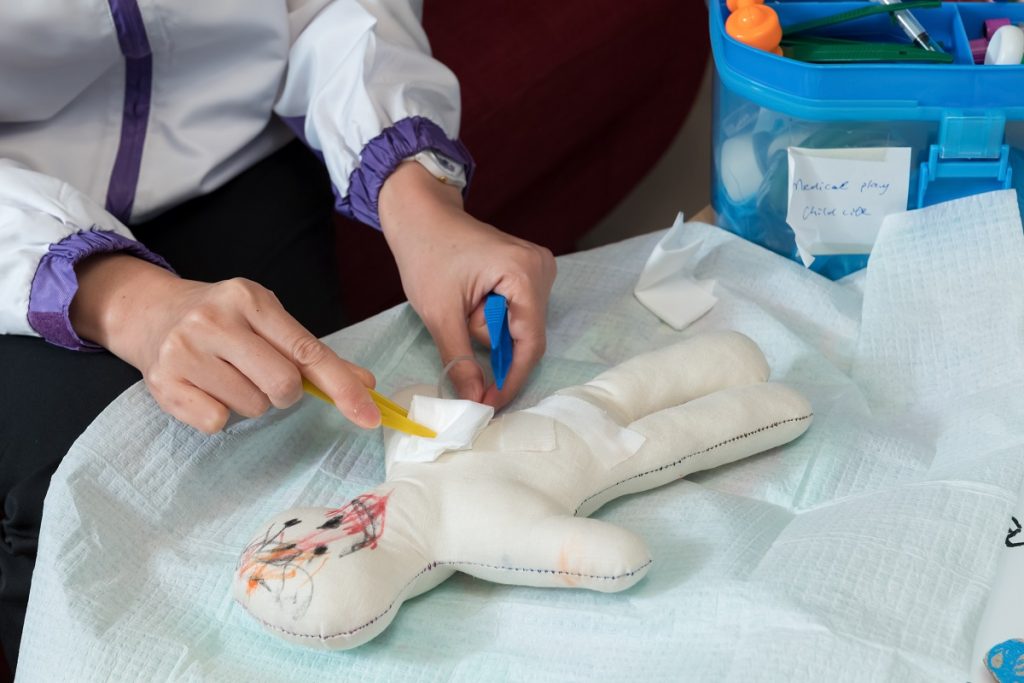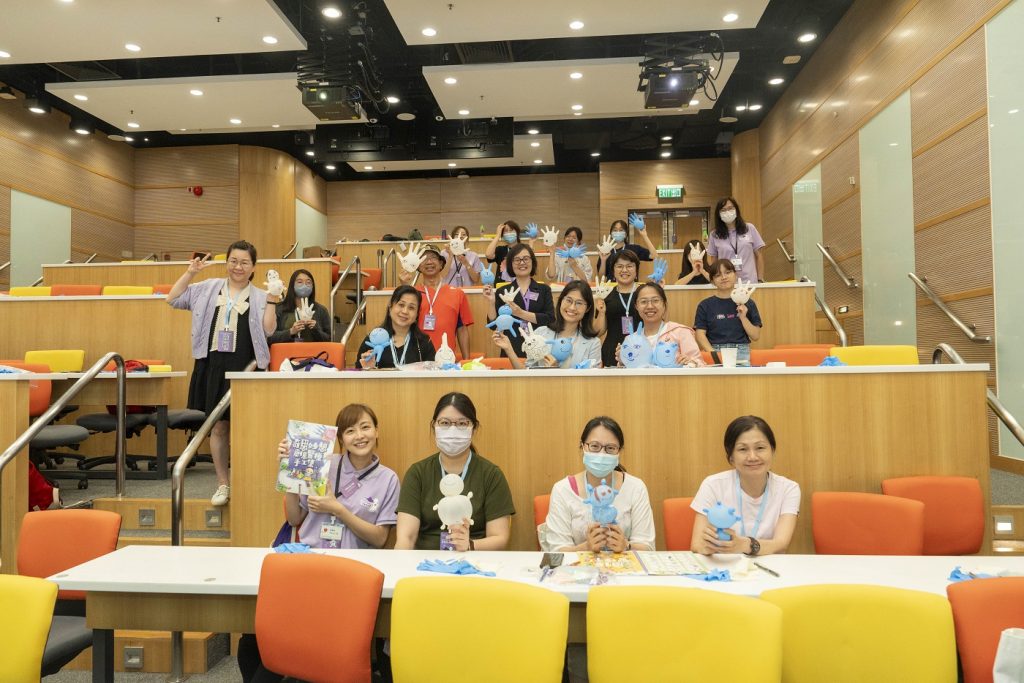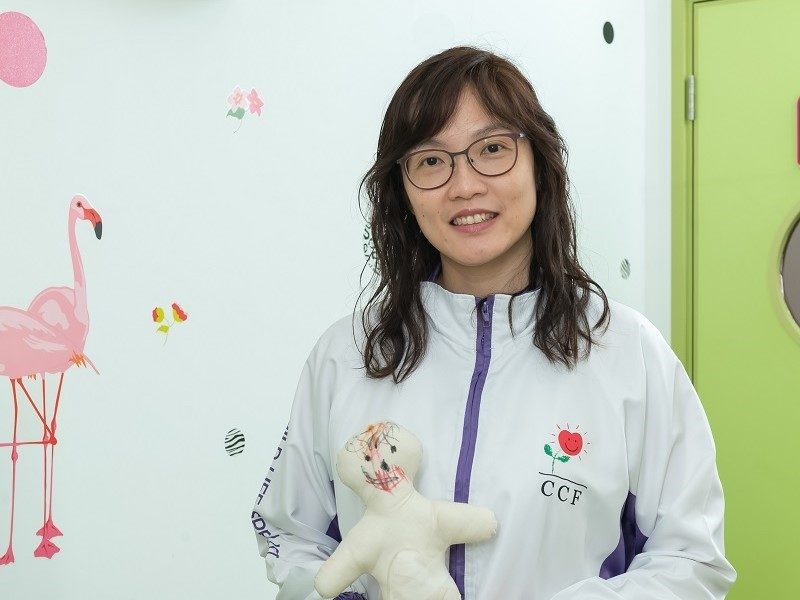Hospitals are often perceived as barren spaces, causing many people to keep their distance unless absolutely necessary. It is no wonder that young, innocent children are fearful when admitted for treatment. Yet, there exists a remarkable profession that resembles real-life superheroes – meet the child life specialists, who bring warmth to the lives of young patients. When children are ill or faced with unexpected medical treatments, these extraordinary individuals step in as their steadfast companions to alleviate their anxiety and stress.
Child life services in Hong Kong
Mandy Chan, Assistant Professional Services Manager of the Children’s Cancer Foundation, is an accredited child life specialist and the only authorised child life clinical internship coordinator in Hong Kong. With over two decades of experience, she firmly believes a safe environment is crucial for unleashing children’s innate coping abilities. As Mandy guides us through her typical workday, we learn to understand and appreciate the indispensable role that child life specialists play in the lives of young patients.
Child life specialists are dedicated to aiding children and their families in overcoming the various challenges of illnesses and treatments. Equipped with a unique blend of medical knowledge, psychological expertise and counselling skills, these remarkable individuals provide invaluable support to children in facing pain, stress and emotional turmoil. Serving as a vital bridge between healthcare professionals, young patients and their families, they establish trusting relationships with children and their families, listen to their needs and concerns, as well as offer emotional and psychological support.
Why have we not heard much about such a crucial role within the healthcare system? It appears that the scarcity of practising child life specialists in Hong Kong is the reason. According to the latest statistics from the Association of Child Life Professionals (ACLP) in April 2023, there are over 6,000 globally recognised child life specialists. However, the total number of qualified professionals in this field across Asia amounts to a mere 95, with only nine practising in Hong Kong.
Like superheroes in the hospital, child life specialists cater to children who are admitted for sudden emergencies, unexpected illnesses or scheduled appointments for examinations and treatments. While their initial focus was on children suffering from cancer or other critical conditions, they later discovered that there is a greater demand for their services in general paediatrics and paediatric wards. In the current public healthcare system, child life specialists do not fall under the purview of the Hospital Authority. Rather, the Children’s Cancer Foundation provides child life services on a voluntary basis at Hong Kong Children’s Hospital’s Haematology and Oncology Department, as well as the Paediatrics and Adolescent Medicine Department at United Christian Hospital and Tuen Mun Hospital.
A typical workday of child life specialists
“Once admitted, every child automatically becomes a recipient of our services. However, due to limited manpower, we must establish a priority order for our services. Children undergoing painful procedures, as well as those scheduled for surgeries, are given priority. Our afternoons are typically dedicated to children who are staying in the hospital for an extended period. Parental counselling is also a vital aspect of our role. For instance, in the unfortunate event of a child’s passing, we provide invaluable support to parents in managing their emotional well-being.”

Mandy often uses simulation and medical games to familiarise young patients with the medical procedures they are about to undergo. She has prepared a plethora of props, ranging from doctor toys to actual medical supplies such as gauze, blood vials and syringes, all of which can be found in her “treasure chest”. In addition, she has specially crafted toys like the outline doll, onto which children can project themselves during playtime. Mandy can then use the doll to simulate, demonstrate and explain the treatment procedures, thereby preparing children mentally and easing their fear and anxiety before their treatment. “Most children enjoy imaginative role play where they can pretend to be doctors or patients. When we incorporate simulated scenarios such as wound cleaning for the dolls, they can better understand the treatment procedures,” Mandy explains. During consultations, Mandy pays extra attention to children’s nuanced reactions towards the medical procedures and
tools. She adds, “We help our young patients express their needs to the medical staff. For example, if a child is afraid of the stethoscope, we will remind the doctor to warm it before it on the patient’s body.”
If children need to undergo a conscious surgical procedure or treatment, such as getting a cast for a fracture, Mandy focuses on communication from a sensory perspective. “During the casting process, we take the time to explain each step. For instance, we will let the young patient know that the cast may feel cold or heavy beforehand. For surgeries that require anaesthesia, Mandy typically stays with the child in the operating room to assist with the placement of the peripheral venous catheter until the anaesthesia has taken effect. “The process of setting up a peripheral venous catheter can make children nervous. Some may even express concerns about waking up in the middle of the surgery or not waking up at all. We are there to lend an ear and offer explanations to alleviate their distress.”
One of the biggest challenges in Mandy’s work arises when she encounters children with intellectual limitations or special educational needs (SEN), as verbal explanations may not be effective in helping them understand the treatment process. This is where their family steps in. Since they know their children best, they can quickly provide valuable insights into their little ones’ preferences to help child life specialists develop the necessary strategies. “I have worked with children who strongly resist medical procedures, perhaps due to unpleasant past experiences, to the point where they refuse to enter the hospital. These kids need more time to warm up. Close communication with their families is essential to understanding where their fear and resistance stem from.”
Children’s medical experience is paramount
Children who need to make repeated visits to the hospital for treatments like laser therapy to lighten birthmarks or vascular nevi receive special attention from Mandy during their first medical experience. Mandy explains, “Not only does laser treatment produce smoke and odour, but it also feels like being snapped by a rubber band. To help children handle subsequent visits with confidence, we make sure to provide detailed explanations of each step of the treatment.” In addition to Mandy’s effort to communicate with the young patients, parents also play a crucial role in understanding and respecting their children before and after each treatment to cultivate their courage. Mandy illustrates this by highlighting instances where parents are too embarrassed to tell their children that they are admitted for a scheduled circumcision. However, withholding information will only destroy children’s trust. Mandy shares, “Being kept in the dark is very frightening for children. Parents should be aware that we always try to communicate with children in a way that they can easily understand, and provide only the necessary information about the treatment to avoid triggering unnecessary fear. When children have a better understanding of the treatment and more autonomy, they will not feel coerced during the procedure.”
Mandy shares a memorable case: “A young boy came for laser therapy to lighten a birthmark on his face. However, he eventually decided to keep the birthmark as it was a connection to his grandfather who also had a birthmark. As he had never met his deceased grandfather, his mother thought it might be an excuse to avoid the laser treatment. Yet, the boy’s decision had a legitimate reason. Adults often analyse situations from a rational standpoint, whereas children place more emphasis on personal feelings.”

How can parents alleviate the stress of hospitalisation for children?
At the three hospitals that offer child life services, parents are welcome to reach out to child life specialists for assistance. The Children’s Cancer Foundation also provides informative videos to educate parents and children about common treatment procedures, such as the insertion of the peripheral venous catheter or vaccine injections. Mandy also shares a variety of practical tips to help children cope with the pressures of hospitalisation: “It is good for families to have a doctor play set at home. During playtime, take the opportunity to explain the role of doctors and foster a positive perception of healthcare professionals. Some parents threaten their children with shots at the doctor’s office, but it will only trigger children’s fear whenever they visit the hospital. In the event that hospitalisation becomes necessary, parents can bring along comforting items like a beloved toy or a familiar blanket to offer children a sense of security. Since children do not have a say in their hospitalisation, it is crucial to prioritise their preferences and give them a semblance of control over their circumstances. Maintaining a regular routine for children is especially important during hospital stays. Medical examinations and medicine deliveries may disrupt children’s usual schedules. Whenever possible, parents should strive to maintain their
children’s routine at home. This can help mitigate any discomfort or unease caused by an unfamiliar environment.” Mandy wants to remind parents to remain calm towards their children’s hospitalisation. While it is natural for parents to worry, excessive anxiety can impact children’s emotional well-being as even young toddlers can pick up on their parents’ emotions. As a result, they may experience anxiety and catastrophic thoughts, fearing the possibility of never returning home or having severe illnesses. To encourage a positive outlook on the medical experience, parents must create a safe environment for their children during their hospital stay and explain that all medical procedures are aimed at facilitating a speedy recovery.
Child life services originated from hospital play services in the early 1990s. In 1992, the Children’s Cancer Foundation initiated the concept of hospital play services in public hospitals to help paediatric oncology patients cope with the challenges caused by their illnesses through play. The team firmly believed that hospital play could help the patients navigate their treatment journey more holistically, which led the Foundation to dispatch its first hospital play coordinator to the United States for Child Life Training in 1997, gaining insights into the professionalism required in child life services. In 2015, the hospital play staff were renamed child life specialists. To further promote child life services in Asia, the Children’s Cancer Foundation recently hosted the Jockey Club Child Life Care Project: 2023 Asia Child Life Symposium. This significant event brought together Asian paediatric experts, as well as healthcare professionals from Mainland China and overseas for professional exchange. Through the interactive workshops, the participants were able to gain firsthand experience of the daily responsibilities and specialised skills of child life specialists.


